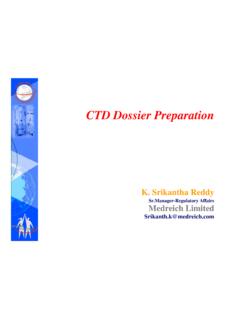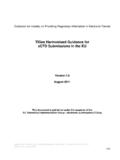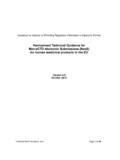Transcription of 2021-09-08-Report on pharmaceutical aspects on impact of ...
1 Official address Domenico Scarlattilaan 6 1083 HS Amsterdam The Netherlands An agency of the European Union Address for visits and deliveries Refer to Send us a question Go to Telephone +31 (0)88 781 6000 European Medicines Agency, 2021. Reproduction is authorised provided the source is acknowledged. 8 September 2021 EMA/504010/2021 European Medicines Agency Final feedback from European Medicine Agency (EMA) to the EU Commission request to evaluate the impact of the removal of titanium dioxide from the list of authorised food additives on medicinal products Executive Summary Titanium dioxide (TiO2) is extensively used as an opacifier and colourant in medicines due to its multiple functionalities1. TiO2 is used very frequently in oral solid dosage forms ( tablets, soft capsules, hard capsules, granules/powders for oral solution and oral suspensions), in oral semi -solid dosage forms ( oral paste, oral gel). It is present in many essential medicines for human including antidiabetics, antibiotics and others and several veterinary medicinal products.
2 TiO2 is also present in dosage forms administered via routes other than oral, , products for cutaneous, inhalation (capsule shells), oromucosal, sublingual, transdermal and vaginal use. To date, no single material has been identified that provides the same combination of properties that are unique to TiO2 ( opacity, enhancing contrast, inertness, protection from UV light and the finish/smoothness of the resulting product ). Separating out the different functionalities of TiO2 for those medicinal products in which it serves more than one function is difficult or might not be possible at all. Possible alternatives identified so far include calcium carbonate, talc and starch. A number of disadvantages have been identified with these alternatives ( inability to obtain sufficiently thin films, supply chain issues, mined materials with associated elemental impurity risk). The feasibility of replacing TiO2 cannot be confirmed at this stage. Each affected medicinal product will need an individual review and assessment, which will require investigation of alternatives, product reformulation, generation of new data related to manufacture, dissolution and stability etc.
3 And potentially new clinical data ( generation of 1 Approximately 91,000 human medicinal products and 800 veterinary medicinal products contain TiO2 in the EU according to EU Trade Associations (see Annex I and II) Final feedback from European Medicine Agency (EMA) to the EU Commission request to evaluate the impact of the removal of titanium dioxide from the list of authorised food additives on medicinal products EMA/504010/2021 Page 2/11 bioequivalence studies ), which subsequently will all have to be assessed by the national competent authorities and EMA. The direct and indirect impacts on medicines for human and veterinary use are expectedto be aggravated in the scenario, where Europe would be the only region globally to banTiO2 as excipient in medicines, which would require industry to develop new formulationsfor the majority of oral solid dose products potentially for the EU only, with titaniumdioxide continuing to be used in the majority of medicines globally.
4 An acceptable transition period for phasing-out TiO2 in all or specific uses in medicinescovered by the scope of colouring matters is currently difficult to envisage or time needed to reformulate each individual product could be several years dependingon the level of formulation and studies required, to be followed by the necessaryregulatory procedures for assessment and approval. Considering the scale of the use of this excipient, the time and costs involved in thereformulation and the volume of products impacted, it is considered that any requirementto replace TiO2 in medicines will almost certainly cause significant medicines shortagesand discontinuations/withdrawals of medicines from the EU/EEA market with majorimplications for patients and animals. Particular concerns arise in relation to certainvulnerable classes/types of products such as paediatric medicines, orphan medicines, lowsales volume products, bee products, etc.).Final feedback from European Medicine Agency (EMA) to the EU Commission request to evaluate the impact of the removal of titanium dioxide from the list of authorised food additives on medicinal products EMA/504010/2021 Page 3/11 Background On 6 May 2021, the European Food Safety Authority (EFSA) published its opinion on the safety of food additive Titanium dioxide (TiO2), recommending that on the basis of all currently available evidence along with all uncertainties, in particular the fact that genotoxicity could not be ruled out, TiO2 can no longer be considered as safe when used as a food additive.
5 On 17 May 2021, the European Commission (EC) requested the European Medicines Agency (EMA) to provide an analysis with the aim to define the technical purpose of titanium dioxide in medicinal products; feasibility of alternatives to replace it without negative impacting the quality, safety and efficacy of medicines; and if confirmed, considerations to be taken into account to define a transition period for phasing out this excipient. To support the analysis, the Agency was asked to seek the input from industry stakeholders. For this purpose, a list of questions was drafted to be addressed by Human (AESPG, EFPIA, Medicine for Europa) and Veterinary (AnimalhealthEurope, EGGVP) industry trade associations. Responses to these questions are provided in Annex I and Annex II. A group composed of Quality Working Party (QWP) experts and relevant EMA departments and Committees have prepared the following responses to the EC request. This report was endorsed/adopted by CHMP, CVMP, CMDh, CMDv and QWP.
6 Question 1: Define the technical purpose of TiO2 in medicinal products, the scope, and the functions of TiO2. Titanium dioxide is listed in Ph. Eur. as a white or almost white powder; it is practically insoluble in water and does not dissolve in dilute mineral acids. It is a simple chemical substance and is widely available. Due to its opacity, whiteness, chemical inertness, and the protection it provides from UV light, titanium dioxide is a widely used excipient in pharmaceuticals. TiO2 is odourless and tasteless, and as such has no negative impact on palatability. It is used frequently in oral solid dosage forms ( , tablets, soft capsules, hard capsules, granules/powders for oral solution and oral suspensions). In veterinary medicinal products, it is also used in oral semi-solid dosage forms ( , oral paste, oral gel). It is present in a number of essential medicines for human including antidiabetics, antibiotics and others and several veterinary medicinal products, for bees.
7 TiO2 is present in a limited number of dosage forms administered via routes other than oral, , products for cutaneous, inhalation (capsule shells), oromucosal, sublingual, transdermal and vaginal use. Titanium dioxide is mainly used as an opacifier and colourant in pharmaceuticals, which implies: Enhancing whiteness and opacity, and accentuation of contrast against other colourants,thereby enhancing distinguishing features of oral solid dosage forms. product colour isimportant for distinguishing different strengths of medicinal products and for feedback from European Medicine Agency (EMA) to the EU Commission request to evaluate the impact of the removal of titanium dioxide from the list of authorised food additives on medicinal products EMA/504010/2021 Page 4/11 Protection of photosensitive active substances from degradation due to exposure to UV/visiblelight. Reducing light permeability of the coating layer contributes to longer shelf-lives and lessstorage restrictions, which allows easier handling and , there is a legislative link allowing the use of colourants listed in Annex II to Regulation (EC) No 1333/2008 in human and veterinary medicinal products without further justification.
8 This has effectively resulted in the function of TiO2 being typically described as a colourant in marketing application dossiers although TiO2 exhibits multiple (highly advantageous) functionalities from a pharmaceutics perspective. Indeed, its multiple functionality is one reason for the widespread use of TiO2. Separating out the different functionalities of TiO2 for those products in which it serves more than one function is difficult or might not be possible at all. A typical example often seen in MA dossiers would be film-coated tablets of multiple strengths, which contain (in the coating) TiO2 at a single concentration across all tablet strengths and additionally, colourants like iron oxide yellow and iron oxide red which are present in the different tablet strengths at different concentrations to produce different coloured tablets. While TiO2 in such a case, is contributing to overall appearance of the tablets (including colour) it does so indirectly by increasing opacity.
9 The intended specific colour (needed to distinguish the different strengths) is actually provided directly by the additional colourants. In case of light sensitive active substances, opacity of tablets would also be relevant for protection from light. Taking the above example into account, it can be concluded that the primary role of TiO2 in medicinal products might be other than as a colourant. For example, increasing opacity is typically more important than providing white colour. Ultimately, it would be the responsibility of the applicant / MAH to justify the functionalities of TiO2 relevant for a specific medicinal product , which would need to be assessed on a case by case basis. In this context, it has to be noted that such a justification is typically not already presented in MA dossiers due to the food additive status of TiO2 and its longstanding and widespread use. TiO2 is monographed in the European Pharmacopoeia and is considered to be suitable for use in the medicinal products as an excipient.
10 Due to its unique combination of physicochemical properties, TiO2 imparts several highly desirable properties to medicinal products. It is widely used in tablet coatings where it can act to prevent light transmission, moisture absorption and improve opacity. Whilst other excipients can also be used for the same purposes in tablet coatings, where due to its physicochemical properties, TiO2 enables the application of a thinner, less brittle coat compared to other excipients, thereby imparting all of these desired quality attributes whilst still allowing rapid bioavailability of the actives once the product is ingested. Reports from National Competent Authority databases and EU s Art 57 database indicate that there are several thousand nationally authorised products per member state containing TiO2. There are also hundreds of centrally authorised products containing TiO2. Human and Veterinary Industry associations have provided data on the number of medicinal products containing TiO2 in relation to the pharmaceutical form (see Annex I and Annex II).














